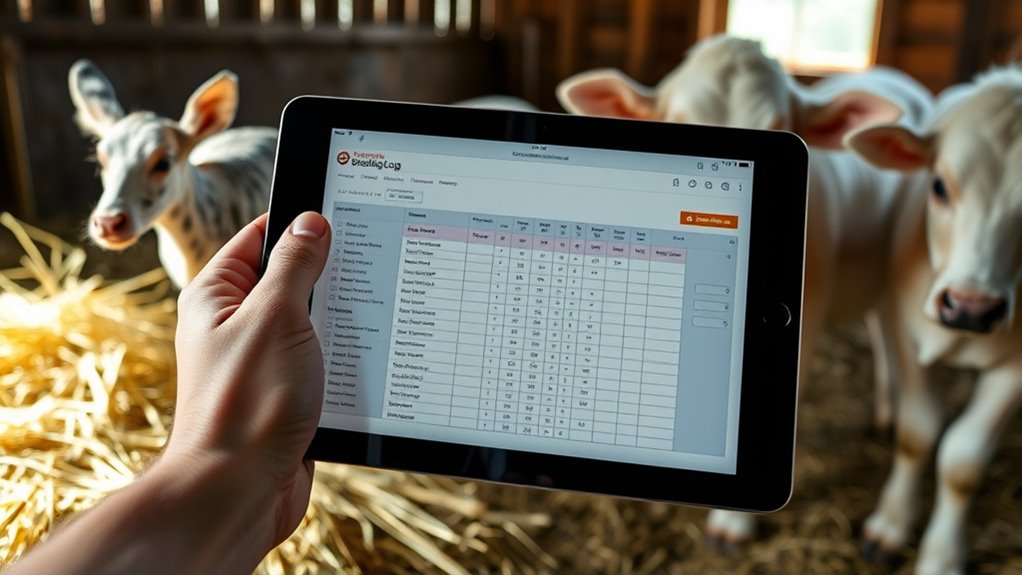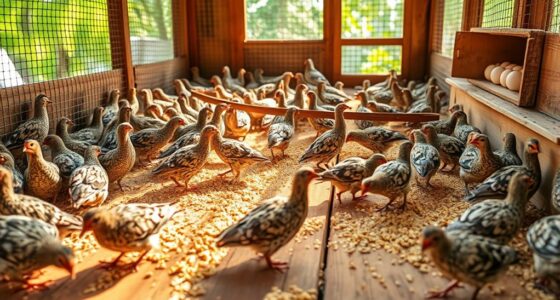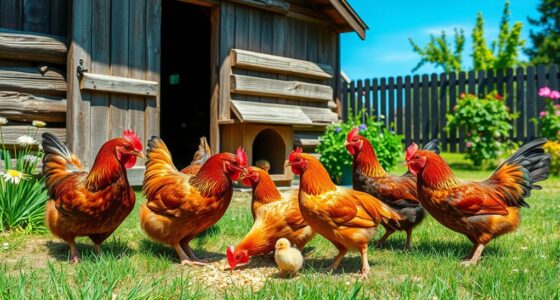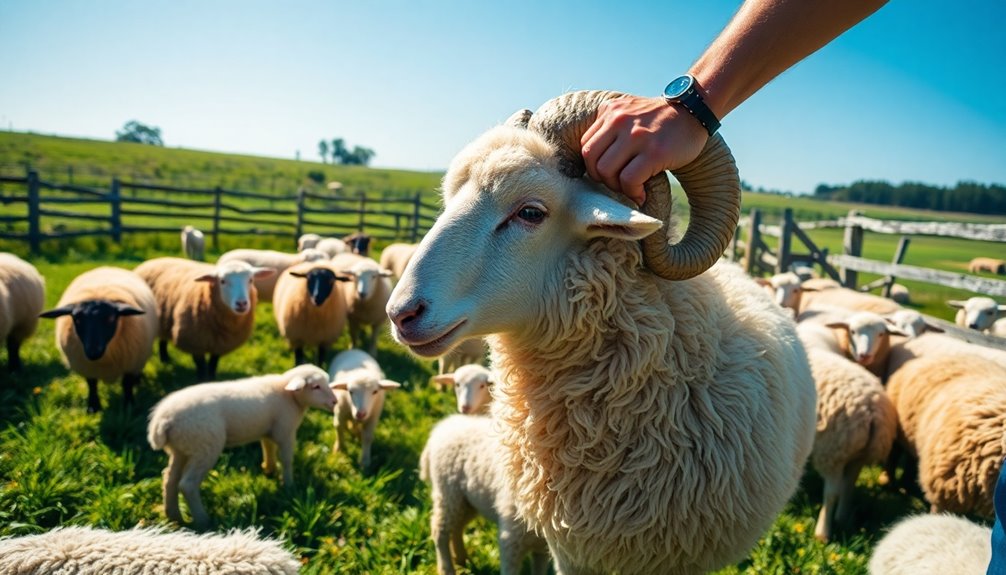To record breeding data for spring 2026 kidding and calving, start by tracking mating dates, sire info, and any observed behaviors or health notes. Use digital tools or logs to organize this information and set reminders for pregnancy milestones and due dates. Monitoring reproductive performance helps you anticipate births and prepare appropriate spaces and supplies. Staying consistent and organized ensures smooth management, and if you keep going, you’ll uncover ways to optimize your herd’s success for spring.
Key Takeaways
- Record exact breeding dates, sire, dam, and mating method to accurately predict spring 2026 kidding and calving timelines.
- Track reproductive behaviors, health status, and environmental conditions during mating to inform management plans.
- Utilize digital tools or apps to log data in real-time, ensuring quick updates and easy access for future reference.
- Monitor pregnancy signs and maintain detailed records to anticipate due dates and prepare birthing areas accordingly.
- Analyze past breeding success and traits to select optimal pairs for desired spring 2026 kidding outcomes.
Importance of Accurate Breeding Records
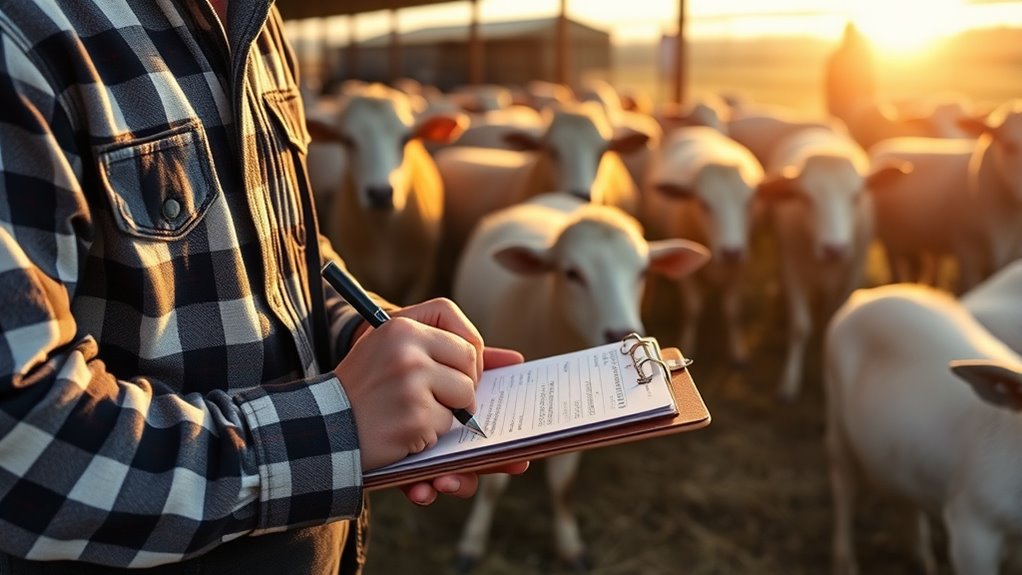
Accurate breeding records are essential because they provide clear insights into your animals’ reproductive history. By tracking details like mating dates, outcomes, and genetic traits, you can make informed decisions that improve your herd’s quality over time. Maintaining precise records upholds breeding ethics, ensuring you select animals based on health, temperament, and desirable traits rather than guesswork. This transparency helps prevent inbreeding and promotes genetic diversity, safeguarding your animals’ well-being. When you document each breeding, you create a valuable database that highlights successful pairings and identifies traits to enhance or avoid. Additionally, record-keeping practices can serve as a financial tool to support long-term planning, ensuring you have resources to sustain your herd management practices. Proper documentation also enables better planning for future breeding seasons and helps in monitoring overall herd performance. Utilizing detailed records can improve the accuracy of your herd’s genetic evaluations, leading to healthier and more productive animals. Ultimately, thorough records support responsible breeding practices, leading to healthier, more productive animals, and fostering a sustainable, ethical herd management approach.
Key Data to Track During Breeding Season
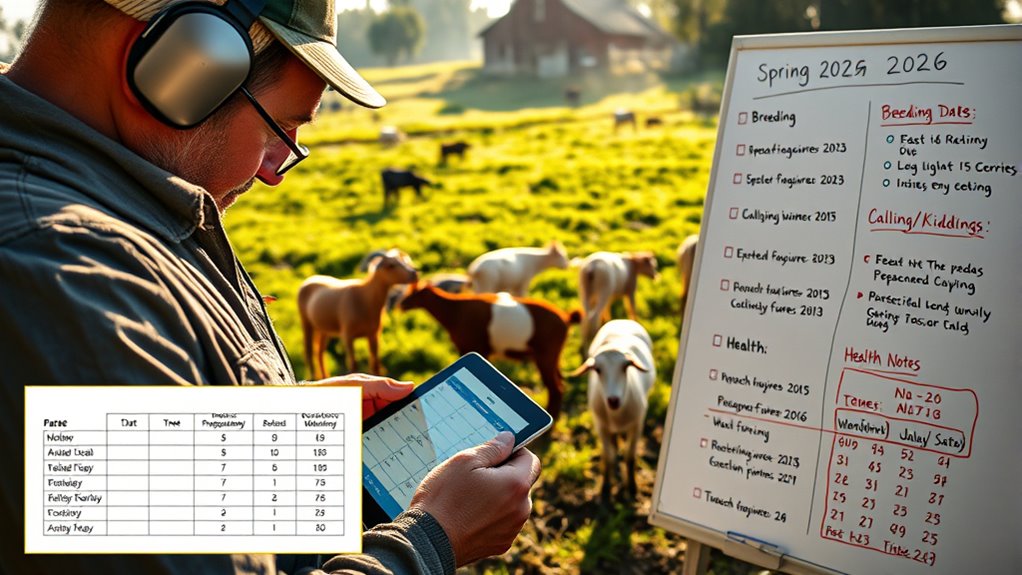
Tracking essential data during the breeding season guarantees you have a clear understanding of each mating’s progress and outcomes. Record details like breeding dates, sire and dam information, and observed behaviors. Pay close attention to genetic traits to identify desirable characteristics for future breeding. Note breed compatibility to ensure successful pairings and avoid mismatches that could affect fertility. Monitoring these factors helps you evaluate which matings produce excellent offspring and improve your herd’s overall quality. Consistently recording data allows you to spot patterns, such as preferred sires or successful breeding times. Maintaining accurate records enhances your ability to make informed decisions and provides a solid foundation for making informed decisions, ultimately leading to healthier, more productive animals and a more efficient breeding program. Additionally, understanding market trends and genetic advancements can help you stay ahead in breeding strategies and optimize herd performance. Recognizing the importance of accurate record-keeping can significantly impact your herd’s genetic improvement over time. Developing a comprehensive data management system ensures that all relevant information is accessible and organized for future reference.
Choosing the Right Record-Keeping Tools

Choosing the right record-keeping tools is essential for efficiently managing your breeding data. Digital logs and mobile apps make tracking mating dates, health info, and pregnancy status simple and accessible. They reduce errors and keep your data organized in real-time. Consider tools that sync across devices for seamless updates. For example, a mobile app can alert you to upcoming breeding milestones or health checks. Use a table to visualize options:
| Tool Type | Features |
|---|---|
| Digital Logs | Cloud storage, easy editing, backup |
| Mobile Apps | Alerts, user-friendly interface, portability |
Selecting tools that suit your operation ensures you stay on top of critical breeding info, saving time and avoiding missed data. Incorporating Layer Concepts can help you better organize and understand your record-keeping system. Implementing automation technology can further enhance your data management efficiency. Utilizing modern technology can further improve your record-keeping accuracy and ease. The right tools streamline your record-keeping, making spring 2026 preparations more manageable.
Recording Mating Dates and Details

Keeping accurate records of mating dates and details helps you monitor your breeding program effectively. By tracking these dates precisely, you can predict calving or birthing times and improve management. Clear records also guarantee you don’t miss important breeding milestones or overlap, making your operations smoother. Monitoring breast cancer symptoms awareness can also translate to better recognition of health issues in your livestock. Additionally, maintaining detailed records supports efficient general ledger coding, ensuring your farm’s financial data remains accurate and compliant.
Accurate Mating Records
Recording accurate mating dates and details is essential for managing your breeding program effectively. Precise records help you make informed decisions about genetic selection, ensuring you choose the best sires for desirable traits. By documenting when and how mating occurred, you can better track reproductive performance and identify successful pairings. These details also streamline breeding season planning, allowing you to predict due dates and prepare for kidding and calving. Consistent, detailed records reduce errors and provide a clear history of each animal’s reproductive activity. This data supports strategic breeding choices and improves overall herd performance. Be sure to record the exact date, method of mating, and any relevant notes immediately after each breeding to maintain accuracy and maximize the usefulness of your records. Additionally, understanding the IRA investment strategy can help plan for financial needs related to breeding and herd management. Keeping detailed records also facilitates compliance with local regulations, which is crucial for legal and insurance purposes. Proper documentation can also aid in analyzing reproductive success rates, allowing for better management decisions in future breeding cycles. Monitoring nutrition and health status during breeding periods can further enhance reproductive outcomes and overall herd productivity.
Tracking Breeding Dates
Tracking breeding dates involves documenting the exact day when mating occurs, along with any relevant details of the event. This helps you monitor genetic traits and predict kidding or calving dates accurately. Recording details like bull or buck used, location, and environmental conditions guarantees you maintain thorough records. It also supports breeding ethics by verifying that all procedures align with responsible practices. Accurate dates enable you to assess breeding success and make informed decisions about future pairings. Consistent tracking helps prevent mistakes, reduces the risk of inbreeding, and promotes genetic diversity. By paying close attention to these details, you assure your herd’s health and productivity improve while adhering to ethical standards. Properly documented breeding dates are essential for successful, responsible herd management. Additionally, understanding how arcade games operate can inspire innovative ways to engage with digital record-keeping tools or educational resources. Maintaining precise records also facilitates genetic tracking, which is crucial for improving herd quality over time. Incorporating reliable record-keeping methods can further enhance your ability to manage your herd effectively.
Monitoring Reproductive Performance
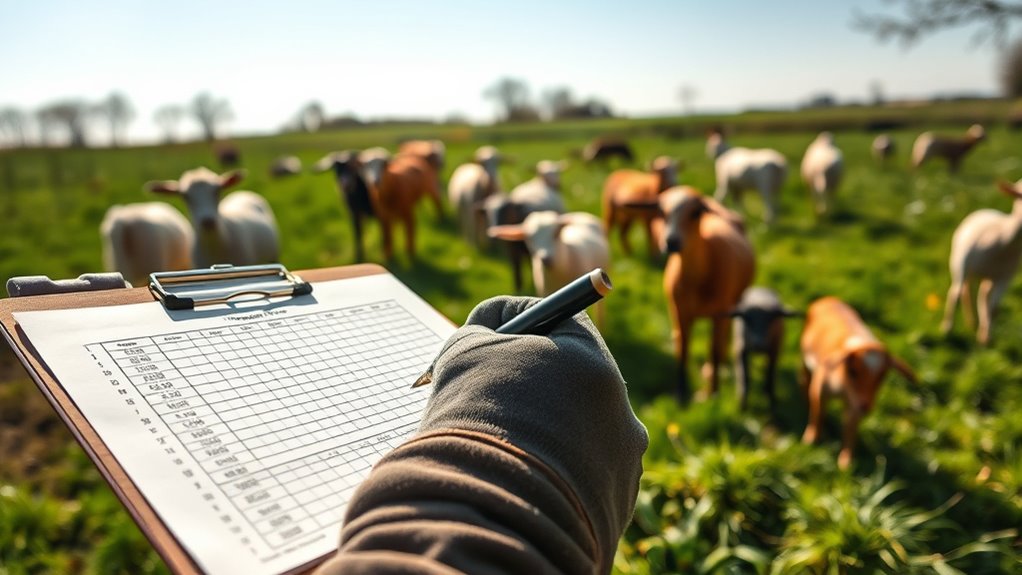
Monitoring reproductive performance is essential for ensuring the health and productivity of your breeding stock. Regularly assess factors like conception rates, cycle intervals, and observed heats to identify issues early. Focus on optimizing genetic selection to improve fertility traits and enhance overall herd performance. Proper feed management supports reproductive health by providing balanced nutrition that promotes successful breeding outcomes. Tracking key indicators such as:
- Return to heat intervals
- Conception and pregnancy rates
- Signs of reproductive disorders
- Breeding success per cycle
Utilizing appliance maintenance plans can help prevent equipment failures that might disrupt breeding schedules and data collection. Additionally, understanding emotional support can be helpful when coordinating with team members or managing the stress associated with breeding management.
Tracking Pregnancy Progress and Expected Due Dates
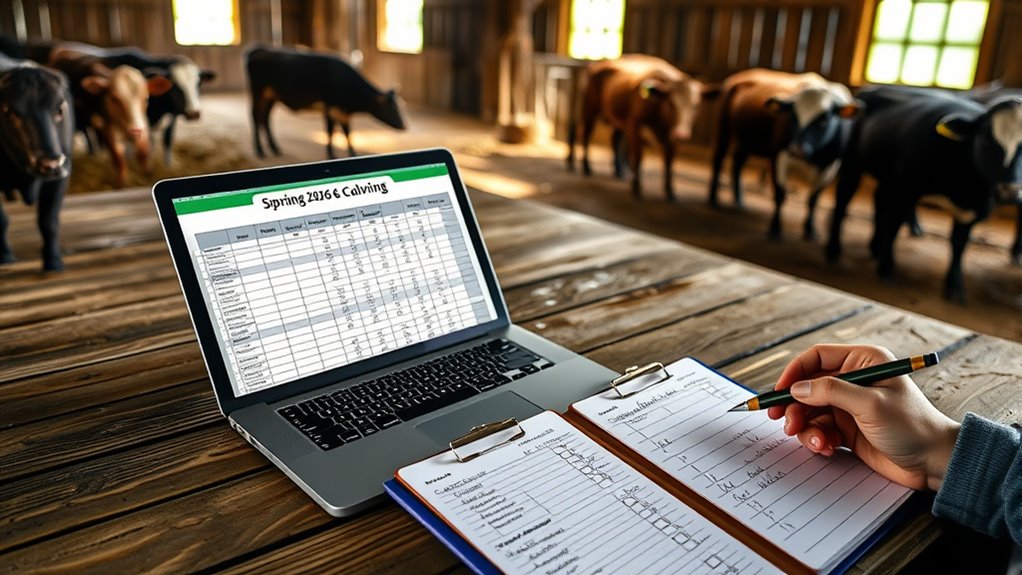
Understanding the progression of pregnancy and accurately estimating due dates are crucial steps in managing your breeding program. By tracking signs like udder development, behavioral changes, and ultrasound results, you can monitor pregnancy progress effectively. Keep in mind that genetic traits influence gestation length, so knowing your animals’ lineage helps predict due dates more precisely. Environmental factors, such as nutrition, stress, and weather, also impact pregnancy development and timing. Regular records of these observations enable you to adjust management practices and prepare for the upcoming birth. Using tools like pregnancy calculators and visual cues ensures you stay on top of expected calving or kidding dates. Accurate tracking minimizes surprises and helps you provide essential care during this critical period.
Preparing for Kidding and Calving Season

As you observe pregnancy signs and keep detailed records, you can better anticipate when your animals will give birth. Preparation involves strategic planning, including genetic selection to ensure strong, healthy offspring and optimizing nutritional plans to support both the dam and fetus. Focus on these key areas:
Monitoring pregnancy signs and records helps ensure healthy, well-prepared births.
- Setting up a clean, comfortable kidding and calving area
- Ensuring access to high-quality feed tailored to gestation needs
- Monitoring for signs of labor and potential complications
- Stocking essential supplies like clean bedding, disinfectants, and calving tools
Prioritizing these steps helps reduce stress during calving and improves recovery. Proper genetic selection influences future productivity, while nutritional planning sustains your animals through this demanding period. Being prepared ultimately leads to healthier births and better overall herd performance.
Analyzing Past Data to Improve Future Breeding

Analyzing past breeding data is essential for making informed decisions that enhance your herd’s future performance. By reviewing records, you can identify which animals excel in traits like milk production, conformation, or fertility. This insight guides your genetic selection, helping you choose sires and dams that improve desirable characteristics. Additionally, understanding market trends allows you to align your breeding program with current demands, such as specific milk qualities or meat attributes. Tracking data over multiple seasons reveals patterns and success rates, enabling you to refine your strategies. This proactive approach ensures you’re not just reacting but adapting your breeding practices to optimize productivity, health, and profitability. Regular analysis ultimately leads to a more resilient, high-performing herd tailored to market needs.
Tips for Staying Consistent and Organized
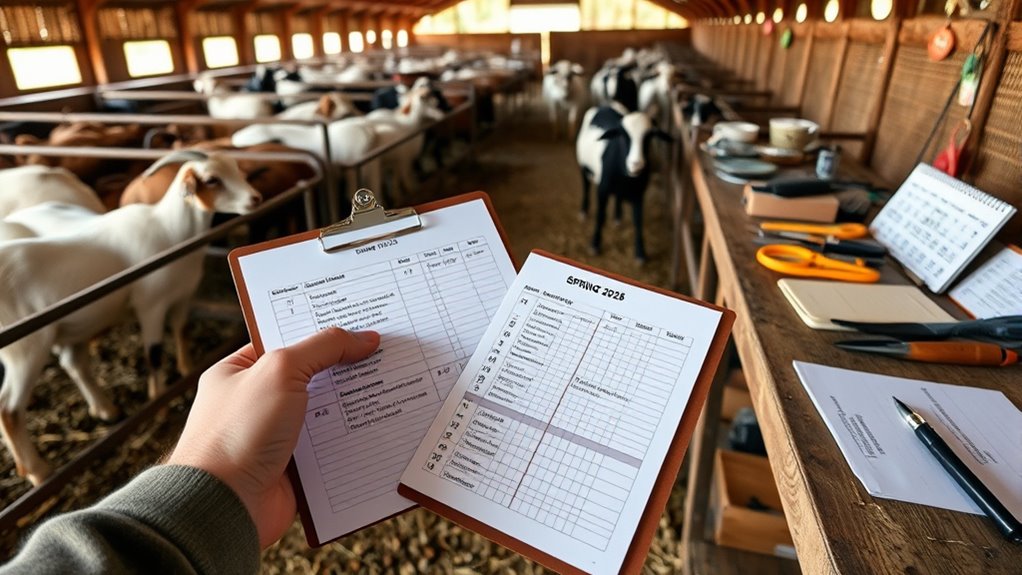
To stay consistent and organized, start using standardized forms for recording breeding data; this helps keep your information clear and uniform. Make it a habit to schedule regular updates so your records stay current and accurate. Don’t forget to back up your data frequently to prevent loss and guarantee you always have a reliable reference.
Use Standardized Forms
Using standardized forms is crucial for keeping breeding data consistent and easy to review. Digital templates and data entry software streamline this process, helping you maintain uniform records. By using the same forms for each animal, you reduce errors and ensure all essential information is captured accurately. Consider these key points:
- Create or select templates tailored for breeding data
- Use digital templates to facilitate quick data entry
- Ensure forms include all necessary fields, like breeding date and health notes
- Maintain consistency by applying the same form across all records
Adopting standardized forms simplifies tracking progress and comparing data over time. It also makes digital data management more efficient, saving you time during record reviews and updates. Staying organized starts with clear, uniform documentation.
Schedule Regular Updates
Maintaining consistent records relies on establishing a regular schedule for updates. Set specific times each day or week to review and record breeding data, ensuring you stay organized and thorough. Seasonal weather can impact breeding and kidding schedules, so note weather conditions during each update to identify patterns or issues. Staying disciplined helps you track breed selection progress and monitor how environmental factors influence fertility and conception rates. Use reminders or calendar alerts to maintain your schedule, preventing data gaps. Steady updates enable you to spot trends early, make informed decisions, and prepare for upcoming breeding seasons. By sticking to a routine, your breeding records will remain accurate, all-encompassing, and easy to analyze, ultimately supporting successful spring kidding and calving outcomes.
Backup Data Frequently
Frequent backups are essential for safeguarding your breeding data against unexpected losses or technical failures. Using reliable recording equipment ensures your data remains accurate and accessible. Regularly backing up your files enhances data security by preventing data corruption or accidental deletion. To stay consistent, consider implementing these practices:
- Use cloud storage for automatic, off-site backups
- Save copies on external drives periodically
- Verify backup integrity regularly
- Keep your recording equipment updated and secure
Frequently Asked Questions
How Early Should I Start Recording Breeding Data for Spring 2026?
You should start your record keeping schedule early in the breeding timeline, ideally a few months before the planned breeding season. This allows you to track key details like heat cycles and breeding dates accurately. By beginning early, you make sure all data is complete and organized, which helps predict calving dates and monitor reproductive health effectively. Starting in advance gives you ample time to prepare for successful spring kidding and calving.
What Are Common Mistakes to Avoid in Breeding Record-Keeping?
Think of your breeding records as the roadmap guiding your herd’s success. To avoid record-keeping errors, stay vigilant about data consistency and double-check entries. Don’t assume memory will hold all details; inaccuracies can lead you astray. Be meticulous and organized, because small mistakes can snowball into bigger problems. Keep your records clear, accurate, and up-to-date, ensuring your herd’s future is built on a solid foundation.
How Can I Integrate Digital Tools With Manual Records Effectively?
You can effectively integrate digital record keeping by choosing a reliable app that syncs seamlessly with your manual records. Regularly update both to guarantee consistency, and set aside time to review data for accuracy. Use app integration features to back up records automatically, reducing errors and loss. This way, you stay organized and can easily access breeding data whenever needed, streamlining your overall record-keeping process.
What Signs Indicate Successful Conception During Breeding Season?
You can tell successful conception by observing visual cues like a swollen, firm vulva and changes in milk production. Behavioral signs include decreased activity, increased rest, and standing heat. During breeding, watch for mounting behavior and acceptance of the buck. These indicators help confirm conception early on, allowing you to plan your management schedule accordingly. Keep tracking these signs consistently for the best success rate.
How Do Weather Conditions Affect Breeding Timing and Data Accuracy?
Like weather’s unpredictable dance, it impacts breeding timing and data accuracy. You should consider how weather impact and temperature fluctuations influence your herd’s reproductive cycles. Cold snaps or sudden warmth can delay or hasten breeding, making your timing less reliable. Monitoring weather patterns closely helps you plan and record more accurate breeding data, ensuring you’re aligned with natural cues and maximizing your herd’s success in the upcoming kidding and calving season.
Conclusion
By keeping detailed breeding records now, you’re setting the stage for a successful kidding and calving season in spring 2026. Stay organized, monitor progress closely, and learn from past data to improve your results. The key details you track could make all the difference when the big day arrives. Are you ready to unleash the full potential of your herd? The next steps could hold surprises—don’t miss out on what’s to come.

